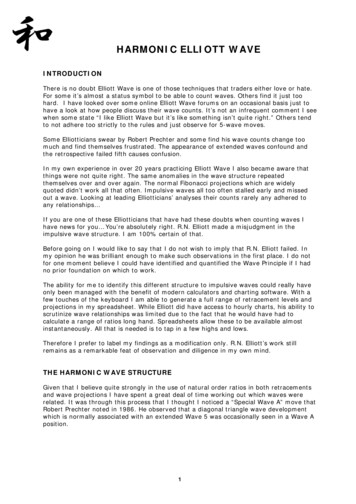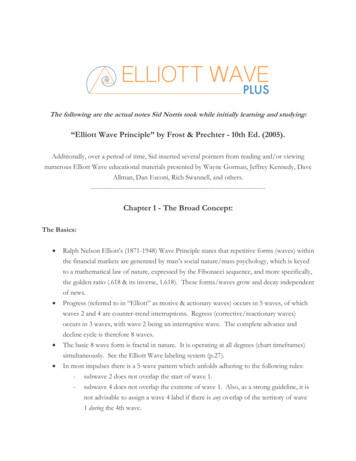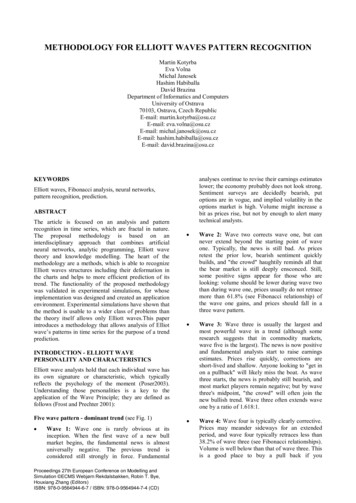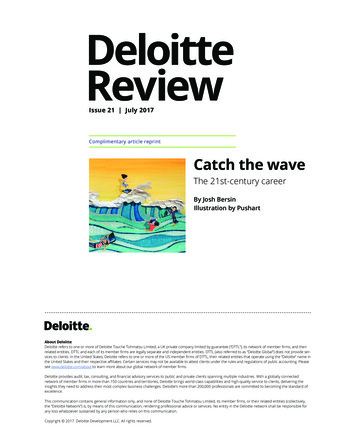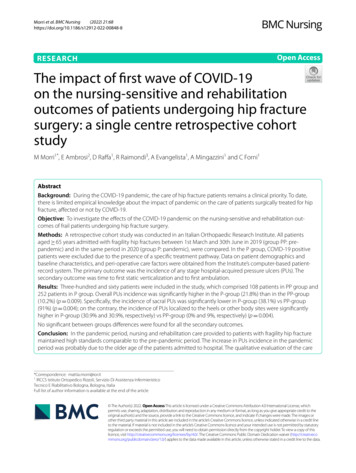
Transcription
(2022) 21:68Morri et al. BMC pen AccessRESEARCHThe impact of first wave of COVID‑19on the nursing‑sensitive and rehabilitationoutcomes of patients undergoing hip fracturesurgery: a single centre retrospective cohortstudyM Morri1*, E Ambrosi2, D Raffa1, R Raimondi3, A Evangelista1, A Mingazzini1 and C Forni1AbstractBackground: During the COVID-19 pandemic, the care of hip fracture patients remains a clinical priority. To date,there is limited empirical knowledge about the impact of pandemic on the care of patients surgically treated for hipfracture, affected or not by COVID-19.Objective: To investigate the effects of the COVID-19 pandemic on the nursing-sensitive and rehabilitation outcomes of frail patients undergoing hip fracture surgery.Methods: A retrospective cohort study was conducted in an Italian Orthopaedic Research Institute. All patientsaged 65 years admitted with fragility hip fractures between 1st March and 30th June in 2019 (group PP: prepandemic) and in the same period in 2020 (group P: pandemic), were compared. In the P group, COVID-19 positivepatients were excluded due to the presence of a specific treatment pathway. Data on patient demographics andbaseline characteristics, and peri-operative care factors were obtained from the Institute’s computer-based patientrecord system. The primary outcome was the incidence of any stage hospital-acquired pressure ulcers (PUs). Thesecondary outcome was time to first static verticalization and to first ambulation.Results: Three-hundred and sixty patients were included in the study, which comprised 108 patients in PP group and252 patients in P group. Overall PUs incidence was significantly higher in the P-group (21.8%) than in the PP-group(10.2%) (p 0.009). Specifically, the incidence of sacral PUs was significantly lower in P-group (38.1%) vs PP-group(91%) (p 0.004); on the contrary, the incidence of PUs localized to the heels or other body sites were significantlyhigher in P-group (30.9% and 30.9%, respectively) vs PP-group (0% and 9%, respectively) (p 0.004).No significant between groups differences were found for all the secondary outcomes.Conclusion: In the pandemic period, nursing and rehabilitation care provided to patients with fragility hip fracturemaintained high standards comparable to the pre-pandemic period. The increase in PUs incidence in the pandemicperiod was probably due to the older age of the patients admitted to hospital. The qualitative evaluation of the care*Correspondence: mattia.morri@ior.it1IRCCS Istituto Ortopedico Rizzoli, Servizio Di Assistenza InfermieristicoTecnico E Riabilitativo Bologna, Bologna, ItaliaFull list of author information is available at the end of the article The Author(s) 2022. Open Access This article is licensed under a Creative Commons Attribution 4.0 International License, whichpermits use, sharing, adaptation, distribution and reproduction in any medium or format, as long as you give appropriate credit to theoriginal author(s) and the source, provide a link to the Creative Commons licence, and indicate if changes were made. The images orother third party material in this article are included in the article’s Creative Commons licence, unless indicated otherwise in a credit lineto the material. If material is not included in the article’s Creative Commons licence and your intended use is not permitted by statutoryregulation or exceeds the permitted use, you will need to obtain permission directly from the copyright holder. To view a copy of thislicence, visit http:// creat iveco mmons. org/ licen ses/ by/4. 0/. The Creative Commons Public Domain Dedication waiver (http:// creat iveco mmons. org/ publi cdoma in/ zero/1. 0/) applies to the data made available in this article, unless otherwise stated in a credit line to the data.
Morri et al. BMC Nursing(2022) 21:68Page 2 of 9administered and the emotional impact of the pandemic on the patients are very interesting topic which woulddeserve further investigation.Keywords: COVID-19, Nursing-sensitive outcome, Rehabilitation, Hip fractureBackgroundThe global health emergency due to the spread ofCOVID-19 has caused unprecedented pressure onthe health systems at all levels [1]. COVID-19 has hada direct impact on the health status of populationsdue to the extremely high numbers of Intensive CareUnit (ICU) admissions and deaths [2, 3], but it hasalso resulted in several equally strong indirect consequences in different fields, even in patients not affectedby COVID [4–7]. In order to cope with the greatdemand of health resources, hospitals have had toinvest human and physical resources, redirecting themfrom other care activities [8]. Aiken et al. [9] highlighted how the redirection of nurses to COVID units,which resulted in the reduction of nurses involved instandard care, as well as the employment of nursingpersonnel lacking context-specific clinical skills due tothe reorganization of care, are to be correlated with anincrease in complications such as pressure ulcers, fallsand urinary tract infections, and mortality, in any typeof patient. Stifer et al. [10] highlight the importance offocusing attention on the "Nurse-Sensitive Indicators"in order to evaluate the patient care quality.In the first phase of spread of the COVID pandemic, all non-essential orthopaedic surgical interventions were postponed, at the same time the decisionto create ad hoc pathways to manage essential interventions ensured the provision of emergency careduring the pandemic. This organizational model hasled to a reduction in the overall number of hospitalized patients, although the number of patients surgically treated for fragility hip fracture has not decreased[11–13].Fragility fractures are associated with higher chancesof clinical worsening in terms of quality of life anddisability in the medium and long term [14]. Following this traumatic event, more than half of the patientsare unable to recover pre-fracture motor skills such aswalking ability [15]. Considering the pandemic impacton patient care, data on patients surgically treated forhip fracture, either COVID-19 positive or not, arelacking.The aim of this study was therefore to investigatethe effects of the COVID-19 pandemic on nursingsensitive and rehabilitation outcomes of frail patientsundergoing hip fracture surgery.MethodsStudy design, setting and sampleA retrospective cohort study was conducted in anOrthopaedic Research Institute in the centre-north ofItaly. All patients aged 65 years or older admitted withfragility hip fractures between 1 st March and 3 0th Junein 2019 (group PP: pre-pandemic) and in 2020 (groupP: pandemic) were compared. Those patients with diaphyseal or pathological fractures, and/or did not signa consent at hospital admission giving permission fortheir data to be used in the future, were excluded. Additionally, for the 2020 cohort patients with a diagnosis ofCOVID were also excluded, due to the different treatment characteristics.The study was approved by the Institute’s Ethics Committee CE AVEC: 27/2021/Oss/IOR. Theresearch protocol was registered on ClinicalTrials.gov(NCT04882670).Patient and public involvement statementPatients or the public were not involved in the design,or conduct, or reporting, or dissemination plans of ourresearch.Standard careHip fracture surgeryEarly surgery within 48 h from the trauma was generally guaranteed. It could be postponed just for medical reasons, such as the need to stop anticoagulants orto stabilize clinical conditions. Patients were admittedeither to an orthopaedic surgery department or to anorthogeriatric department, depending on beds’ availability. The duty orthopaedic surgeon, based on thepatient’s age, clinical conditions and type of fracture,established the surgical technique.Pressure ulcers (PUs) preventive careAll patients were assessed for PU risk through theBraden Scale [16] at hospital admission, and, if theBraden score was 17, they were placed on a higher‐specification foam or a dynamic anti-decubitus mattress within 24 h. Staff nurses assessed patient pressurepoints at least daily and guaranteed routine positioning every four hours after surgery in order to minimizefriction and shear. Skin care was carried on accordingto EPUAP guidelines [17].
Morri et al. BMC Nursing(2022) 21:68In‑hospital rehabilitationThe inpatient rehabilitation treatment started one dayafter surgery. It consisted of two 30-min physiotherapy sessions a day from Monday to Saturday aimingat obtaining an early sitting and standing position andthen walking.Post‑hospital rehabilitationAfter the hospitalisation phase, a pathway was definedfor each patient tailored to their rehabilitation and careneeds and community resource availability.Timing and techniques of hip fracture surgery, PUspreventive care and in-hospital rehabilitation treatmentshave been the same in the PP and P periods.Hospital reorganization during pandemicDuring the COVID-19 pandemic, our hospital, which isusually devoted to the management of complex orthopaedic surgical cases, including tumor, infections, andrevision surgery, with trauma cases normally representing less than 30% of its overall surgical activity, becamethe reference center for the treatment of orthopaedicemergencies in one north-eastern Italian city with about400.000 inhabitants. Thus, an extensive rearrangementof surgical activity and clinical protocols was undertakenin order to support this change. Moreover, all the procedures aimed at preventing and containing the spreadof COVID-19 were put in place according to availablenational and international guidelines [18, 19]. The activity related to elective surgeries was suspended throughout the hospital; thus, four out of eleven surgical units,such as those dedicated to reconstructive orthopaedicsurgery, shoulder and elbow surgery, private surgery, andpost-operative functional recovery and rehabilitation,have been temporarily closed. Furthermore, the unitsdevoted to musculoskeletal cancer surgery and to oncological and degenerative spine surgery were temporarilyconsolidated into a single unit. Outpatient services werealso suspended.One another note, during the pandemic period 126healthcare professionals (out of a total of 1457), havebeen absent due to illness or diagnosis of Covid-19. Inorder to replace these absences, the healthcare professionals employed in those units whose activity was suspended were transferred to cover their ill colleagues offunctioning units. The hospital management created alsoa department dedicated to the hospitalization of orthopaedic patients with confirmed/probable/suspectedCOVID-19 diagnosis. In this regard, one operating room(previously devoted to the management of infections ofthe musculoskeletal system) was converted to host surgeries of COVID positive patients. This reorganizationPage 3 of 9led to an important flow of the nursing and physiotherapy staff within our hospital to guarantee pre-pandemicstandards of care, but it was not always possible to consider the professionals’ specific clinical skills.In addition, in three surgical units which were openduring the pandemic period, temporary closures havebeen determined to contain the spread of COVID-19hotspots among healthcare personnel and in-patients.MeasuresThe primary outcome was the incidence of any stagehospital-acquired PUs. PUs are one of the most frequentcomplications in hip fracture patients, ranging from 8.8%to 55% in the International literature [20], and an independent predictive factor of one-year mortality aftersurgery [21]. Moreover, several authors have identifiedhospital-acquired PUs as a major nurse-sensitive outcome [22]. Both PU definition and staging have beendetermined following the EPUAP classification [17]. Thesecondary outcomes included time (in days) required toachieve, assisted or independently, standing and walk forthe first time. Moreover, data on overall hospital admission volume and in-hospital mortality for all types of surgery in the two groups (PP group and P group) were alsocollected. The following possible predictive factors forprimary outcome, as identified by research team’s clinical experience and available literature [23–25], were alsoassessed:-patient demographics and baseline characteristics(age, gender, pre-existing PUs at hospital admission,Braden score [16], hip fracture type;-peri-operative care factors: time to surgery (days), typeof surgical procedure (osteosynthesis vs. arthro- or endoprothesis surgery), use of anti-decubitus air mattress,insertion of a urinary catheter during hospitalizationand length of time it remained in situ (days), changes ofposition while in bed of those expected (at least 4 daily),which were performed every 4 h, overall and pre andpost-operative length of hospital stay (days), presence ofa urinary catheter at hospital discharge.All the above cited data were routinely recorded inthe patient electronic clinical record by the Physician,the Registered Nurse, or the Physiotherapist on duty,as appropriate. For the present study, data (for both PPand P periods) were retrospectively extracted from theInstitute’s computer-based patient-record system by aresearch Registered Nurse and a Physiotherapist.Statistical analysisTo compare the two groups (P group vs PP group), theχ2 test or Fisher’s exact test (where appropriate) wereemployed for categorical variables; the Mann–Whitneytest was applied for continuous variables. The relative risk
Morri et al. BMC Nursing(2022) 21:68of developing PUs was estimated using a log-binomialregression model. Considering the observational designof the study, two different analyses were performed toreduce confounding: one based on the log-binomialregression model, adjusted for Propensity Score (PS), andone based on the change-in-estimate.The PS showed the probability of having been hospitalized between March and June 2020 and it was calculatedusing a logistic regression model including the followingvariables: gender, age at hospitalization, Braden score,number of days with catheter, fracture of the femoralneck, length of stay. The log-binomial regression modelwas then estimated by including the variable that identifies the pandemic group together with the PS.As a sensitivity analysis, the log-binomial regressionmodel was also estimated by a stepwise selection of thevariables listed above, by including those that resultedin the largest change of the point estimate of the relative risk comparing the two cohorts (change-in-estimateapproach). In detail, starting from the model estimatethat included only the cohort variable, the variable thatproduced the largest change of the relative risk of thecohort comparison was added at each step in the model.When the inclusion of each additional variable produceda change of the relative risk of less than 5%, the selectionprocedure was stopped. All analyses were performedwith Stata 11.2 (StataCorp, College Station, TX).Fig. 1 Flow DiagramPage 4 of 9ResultsThere were 360 patients who underwent hip fracture surgery in this study, which comprised 108 patients in PPgroup and 252 patients in P group. The patient flowchartis shown in Fig. 1. The increase in number of patientsadmitted with a hip fracture diagnosis was of 133% during the pandemic period compared with pre-pandemicperiod in 2019. On the contrary, overall inpatient hospital admissions decreased by 44% in pandemic period in2020 (1956 patient admitted) compared to pre-pandemicperiod in 2019 (3645 patients admitted). The percentage of patients who underwent hip fracture surgery inPP group was almost 3%, without no significant monthto-month variation. On the contrary, during pandemicthe rate of hip fracture patients surgically treated haschanged over time with a percentage increase by 8.9% inMarch, 19.7% in April, 15.4% in May, 9.8% in June compared to 2019. Overall, in-hospital mortality rates (calculated on all admitted patients) increased from to 0.1%(N 4) in the PP period to 0.9% (N 17) in the P period(p 0.001).Profile of hip fracture patients admitted during pandemicTable 1 and 2 compares the patient demographics,peri-operative care factors and outcomes of the twogroups. Comparing the sample’s characteristics in relation to the hospital admission period, the PP-group
Morri et al. BMC Nursing(2022) 21:68Page 5 of 9Table 1 Patient demographics, baseline characteristics and peri-operative care in the pre-pandemic (PP) and pandemic (P) groups.Values are numbers (percentages) unless stated otherwisePP (n 108)P (n 252)Overall (n 360)p-valuePatient demographics and baseline characteristicsFemale gender, n (%)81 (75.0)199 (79.0)280 (78.0)0.41Median (IQR) age, (years)82 (12)86 (10)85 (11)0.006Presence of PUs at admission, n (%)10 (9.3)17 (6.8)27 (7.6)0.70Patients with a femoral neck fracture, n (%)74 (68.5)120 (47.6)194 (54.0)0.001Median (IQR) Braden Index scorea15 (2)15 (2)15 (2)0.22Peri-operative careMedian (IQR) length of stay (days)8.5 (4)9.0 (6)9.0 (5)0.015Median (IQR) pre-operative length of stays (days)2 (1)1 (1)1 (1)0.03Median (IQR) post-operative length of stays (days)7 (4)7 (6)7 (4)0.004Patients with an anti-decubitus air mattress, n (%)97 (89.8)209 (82.9)306 (85.0)0.094Patients with a urinary catheter inserted in hospital, n (%)76 (70.4)173 (68.7)249 (69.2)0.75Patients with a urinary catheter inserted in hospital or at home, n (%)91 (84.3)230 (91.3)321 (89.2)0.05Patients with a urinary catheter at discharge, n (%)41 (38.0)94 (37.3)135 (37.5)0.91Median (IQR) days with a urinary catheter7 (4)8 (5)7 (5)0.017Median percentage (IQR) of changes of position while in bed of those excpected. 88 (11)100 (8)92 (17)Patients with Osteosynthesis surgery, n (%)133 (52.8)179 (49.9)46 (43.0) 0.0010.074Pus Pressure Ulcers, IQR interquartile rangeaBraden Index score from 6, severe risk, to 23, no risk of pressure ulcersTable 2 Outcomes in the pre-pandemic (PP) and pandemic (P) groups. Values are numbers (percentages) unless stated otherwisePP (n 108)P (n 252)Overall (n 360)p-value11 (10.2)55 (21.8)66 (18.3)0.00910 (90.9)21 (38.2)31 (47.0)Primary outcomePUs incidence, n (%)PUs anatomic locationSacrum, n (%)0.004Heel, n (%)0 (0)17 (30.9)17 (25.8)Other locations, n (%)1 (9.1)17 (30.9)18 (27.2)3 (30.0)18 (33.3)21 (32.8)PUs stageStage I, n (%)0.837Stage II, n (%)7 (70.0)36 (67.7)43 (67.2)Median (IQR) time to PU development (days)6 (3)4.5 (6)4.5 (4.7)59 (54.6)144 (57.1)203 (56.4)0.587Secondary outcomesFirst standing, n (%) 2 days0.37 2 days44 (40.7)88 (34.9)132 (36.7)Never5 (4.7)20 (8.0)25 (6.9)Median (IQR) time to first standing (days)2.0 (1.5)2.0 (2.0)2.0 (2.0)57 (52.8)120 (47.6)177 (49.2)First Ambulation, n (%) 3 days0.340.65 3 days28 (25.9)75 (29.8)103 (28.6)Never23 (21.3)57 (22.6)80 (22.2)Median (IQR) time to first ambulation (days)3 (2)3 (2)3 (2)0.59
Morri et al. BMC Nursing(2022) 21:68and P-group were homogeneous in the terms of thepatient characteristics, with the exception of medianage (82 years in PP-group vs 86 years in P-group;p 0.006) and the type of fracture (femoral neck fracture 68.5% in PP-group vs 47.6% in P-group; p 0.001).With regard to peri-operative care factors, a statistically significant difference was found for some variables(Table 1). In particular, those patients admitted during the pandemic experienced a longer—overall andpost-operative—in-hospital stay (p 0.015 and 0.004,respectively) than those who were admitted in the prepandemic period. Moreover, they were more exposedto changes of position while in bed (88% in PP-groupvs 100% in P-group; p 0.001), and to the presence of aurinary catheter inserted both before and after hospital admission (84.3% in PP-group vs 91.3% in P-group;p 0.05); although the number of catheters insertedduring hospitalization was not significantly differentbetween the two groups (p 0.75).Considering the primary outcome, a statistically significant difference was found in PUs incidence (10.2in PP-group vs 21.8% in P-group; p 0.009). The incidence of sacral PUs was significantly lower in P-group(38%) vs PP-group (91%) (p 0.004); on the contrary,the incidence of PUs localized to the heels or otherbody sites were significantly higher in P-group (30%and 30%, respectively) vs PP-group (0% and 9%, respectively) (p 0.004).No statistically significant differences were foundbetween groups for all the secondary outcomes(Table 2).Relative risk of pressure ulcers and predictive factorsFrom the analysis of the unadjusted risk ratio for thetwo periods taken under consideration, the resultsshowed that the relative risk (RR) of pressure ulcersamong patients admitted to hospital during the pandemic was 2.07 as compared to those patients admittedduring the pre-pandemic period (p 0.019) (Table 3).Analyses performed using the PS approach (adjustingfor age, gender, Braden Index score, days with a urinary catheter, fracture type and length of stay) showeda reduction in the RR of PU comparing the two periods(RR 1.63, p 0.127). This evidence is also confirmedby adjusting the comparison using the change-in-estimate strategy. As shown in Fig. 2, the main unbalancedfactors between the two periods that influenced thecomparison were age and length of stay. Adjusting forthese factors, the RR was nearly coincident with thatestimated with the PS approach (RR 1.64, p 0.121).Further adjustment for the other factors produced negligible RR changes ( 5%).Page 6 of 9Table 3 Effect of year of admission on risk of PU based onlog-binomial model. Based on 351 patients with completeinformation for the calculation of propensity score aRisk Ratio 95% CIp-valueCrude effect2020 vs 20192.071.13–3.810.019Change-in-estimate adjustment1.640.88–3.070.121Length of stay, per 1-day increase 1.072020 vs 20191.03–1.10 0.001Age, per 1-year justed for Propensity scorea2020 vs 2019aAge, gender, Braden Index score, days with a urinary catheters, fracture siteand length of stayDiscussionThe COVID -19 pandemic forced the settings of anorthopaedic surgery hospital into a deep transformationof its organizational model, with a consistent modification of both its admission volumes and the most frequenttype of surgery performed. The data of this researchstudy highlight a 44% reduction in the number of admissions, with a simultaneous increase in the number of surgical operations due to fragility hip fracture. These resultsare confirmed by the findings of Wong et al. [26] in HongKong and by Hampton et al. [12] as regarding the Englishcontext, they both present similar trends.From a perspective of “Nurse-Sensitive Indicators”, theresults of our study indicate that the incidence of PUs inpatients with fragility hip fractures increased notably:between the pre-pandemic period and the pandemicthe incidence of this outcome went from 10 to 22%. Asregarding the characteristics of the ulcers, no significantchanges were noticed in terms of day of onset and lesionsstage, on the contrary the PUs place of occurrence variednotably compared to the pre pandemic period. In 2019,91% of all pressure ulcers were located in the sacrumarea, however in 2020 the PUs incidence at the sacrumdecreased to 38%, while the frequency of PUs located inother pressure points, such as heels, increased to 31%.Prior to the pandemic, Chiari et al. [25] explored the PUsincidence in a cohort with characteristics comparable toour current study population and reported a 64% incidence to the sacrum, 23% to the heels and 13% to otherlocations. Due to the small number of events recordedover the pandemic period, it hasn’t been possible toascertain if the difference registered over this period maybe related to the reorganization of the daily activities ofclinical practice in many units or if it may be due to otherfactors. However, given the results of this study, we consider important to remind to all the health professionals
Morri et al. BMC Nursing(2022) 21:68Page 7 of 9Fig. 2 Change-in-estimate of Relative Risk for pressure ulcers incidence between pandemic period vs pre-pandemic periodthat PUs prevention and monitoring cannot be focusedonly on the most commonly affected areas such assacrum and heels, but they must include close monitoring of all body pressure points.The unadjusted risk ratio for the development of pressure ulcers in relation to both the periods under exam,the pre-pandemic period in 2019 and the pandemic in2020, has been found to be 2.07. The calculation of therelative risk ratio, adjusted for the significant risk factorsemerged from the study, specifically age and length ofstay, did not confirm the initial unadjusted score and itsstatistical significance. This demonstrates how these tworisk factors have been the main responsible for the incidence variations found in the two periods.In this regard, it is also interesting to notice that thedifference of median age among the two cohorts is4 years. The results of the present study indeed highlight age as a risk factor for the development of PUs andthis is confirmed by multiple other studies [24, 25] inthis patient population. In the same way, length of staywas identified as a risk factor for the development ofPus, confirming results of previous studies [27, 28]. Onthis matter it should also be considered that the pandemic has heavily affected the hospital length of stay ofany patient category, not just COVID-19 patients, leading to difficulties in the organization of post-dischargerehabilitation pathways. Many outpatient rehab facilities and long-term care facilities either had to convertunits or had to become hubs dedicated the treatmentand care of COVID patients, therefore disrupting theirusual capacity to receive orthopaedic patients discharged from the hospital. Furthermore, communitymedicine services were also heavily impacted by thehigh number of patients in need to be followed at homeand by the new laws imposed by the Italian governmentin order to contain the spread of the virus.Nevertheless, the analysis of the median time to PUsonset for the 2020 cohort showed similar timing to thepre-pandemic period, suggesting that patients tend todevelop pressure ulcers during the first period/phase oftheir admission.On the other hand, the investigation of other indicators of nursing sensitive outcomes, which have beenpreviously found in the literature to be associated withpressure ulcers prevention, such as prolonged urinarycatheterization, use of the anti-decubitus mattress,bed mobilization and early walking, did not underwentvariations over the two periods examined. These findings allow us to assume that the quality of care receivedby the patients did not decrease during the pandemicperiod and that the healthcare workers continued tocorrectly apply the standard procedures for PUs prevention. These positive outcomes are confirmed alsolooking at the physiotherapy treatment administered tothe patients over the pandemic period. The recovery ofthe ability to stand and to walk was achieved at an earlystage, with an identical timing compared to 2019.These results witness that the healthcare professionals were able to maintain and offer to the patients thesame levels of care guaranteed prior to the pandemic,although under extremely stressful conditions. Thequalitative evaluation of the care administered andthe emotional impact of the pandemic on the patientsare very interesting topic which would deserve furtherinvestigation.
Morri et al. BMC Nursing(2022) 21:68LimitsThis is a retrospective study; however, the collected datahave been accurately checked and they are exhaustive.Therefore, they allow an adequate statistical analysis ofboth the primary outcome and of the other rehabilitation and nursing sensitive outcomes. Currently in theliterature there are not many studies containing data onnursing sensitive outcomes and consequently it has beendifficult to compare our results with other institutions.On the other hand, one of the strengths of this study isthe analysis of the data on the quality of the clinical careadministered to the patients during the pandemic, withthe objective to understand how institutions and healthprofessionals reacted to the reorganization of the healthservices imposed by the global pandemic and how theyperformed, not just in the treatment of COVID-19patients but also in the care of all hospitalized patients.ConclusionOver the pandemic period, the clinical activities, as wellas the nursing and physiotherapy care administered tofragility hip fracture patients maintained high standardsof care, similar to the pre-pandemic standard of care. Thedevelopment of pressure ulcers over the pandemic periodincreased, probably due to the older age of the patientsadmitted to the hospital.AbbreviationsICU: Intensive Care Unit; PP: Pre-pandemic; P: Pandemic; PU: Pressure ulcer; PS:Propensity Score; RR: Relative Risk.AcknowledgementsWe thank all physiotherapists and nursing staff in hospital for their extraordinary work during the pandemic.Authors’ contributionsFC, AE and MA designed the study. RD and RR enrolled the patients andextracted the data. EA, MM and FC performed statistical analyses. AE, MMdrafted the first versions of the manuscript. FC, MA and EA critically revised thefirst version of the manuscript. All authors reviewed and approved the finalversion of the manuscript.FundingOpen access publication of this study has been funded by Fondi 5 1000anno 2018. Not financial support was provided for the design of the study andcollection, analysis and interpretation of data and in writing the manuscript.Availability of data and materialsThe datasets used and/or analysed during the current study are available fromthe corresponding author on reasonable request.DeclarationsEthics approval and consent to participateThe study was approved by the “Comitato Etico Area Vasta Emilia Centro dellaRegione Emilia-Romagna” (CE-AVEC) with number 27/2021/Oss/IOR. According to Italian Low (D.L
sensitive and rehabilitation outcomes of frail patients undergoing hip fracture surgery. Methods Study design, setting and sample A retrospective cohort study was conducted in an Orthopaedic Research Institute in the centre-north of Italy. All patients aged 65 years or older admitted with fragility hip fractures between 1st March and 30 th June



